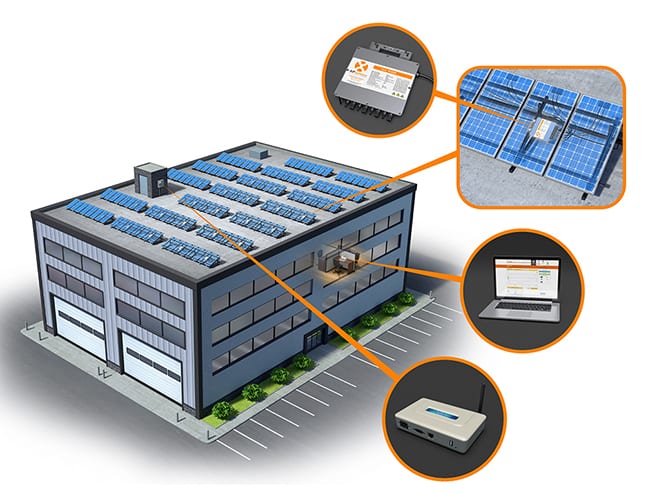Lighthouse & Bombard earn prestigious APsystems Project of the Year awards
Lighthouse Solar is honored in the Residential category for their efforts in making PV systems a more standard feature in planned solar communities in the San Antonio area.
Lighthouse Solar is honored in the Residential category for their efforts in making PV systems a more standard feature in planned solar communities in the San Antonio area.
APsystems, the global leader in advanced microinverter technology for the solar PV industry, today announced its commitment to Extend the Day, a charity organization which gives solar reading lights to school children in disadvantaged countries with no access to electricity.
APsystems will donate $1 to the nonprofit for every microinverter purchased up to the amount of the charity’s 2017 administrative expenses for its Lights for Learning program.
“APsystems is proud to partner with Extend the Day to bring light to these children’s lives.” said Dr. Zhi-min Ling, APsystems Global President & CEO. “We firmly believe in what Extend the Day is doing around the world and are committed to helping them continue to achieve measurable results with their Lights for Learning program.

“This foundation commitment by APsystems is extraordinary,” said Extend the Day Executive Director Jo Lonseth. “It allows us to focus on expanding our reach and building on the successful projects we already have in Kenya, Nepal and Myanmar. Success in life for children living in disadvantaged communities often comes down to whether or not they can continue their middle school education. These solar powered lights cost nothing to operate and make it possible for school children to do homework after dark, improve their grades, and stay in school.”
APsystems first learned about the impressive work that Extend the Day is doing when the non-profit asked APsystems for help in designing a more reliable, lightweight, and inexpensive solar powered light. As a world leader in the development of innovative solar power electronic solutions, APsystems was the right choice and eagerly worked with Extend the Day to develop the ideal solution.
For more information on Extend the Day: extendtheday.org
Bainbridge Island Museum of Art near Seattle has earned the vaunted LEED Gold environmental certification, making it the first new art museum in Washington state to achieve the Gold rating.
The certification is thanks to a newly expanded solar array using APsystems YC500 dual-module microinverters.
This past fall the museum nearly doubled its array to 100 modules. The 28kW system caps a host of advanced sustainability features that extend from the roof down into the earth beneath the museum itself.

“What’s thrilling about this achievement is that it affirms how deeply Bainbridge Island and the museum itself care about all aspects of community vitality and wellbeing,” said Sheila Hughes, BIMA Executive Director. “We live, work, visit and raise families in a place that invests equally and deeply in cultural enrichment and in sustainability.
“It’s wonderful to see BIMA’s LEED Gold status, made possible through the generosity of its local donors, as a leading example of both.”
The U.S. Green Building Council’s LEED certification – for Leadership in Energy and Environmental Design – is a progressive code that rates new buildings for sustainability and promotes eco-friendly construction techniques.
Designed by Bainbridge architect Matthew Coates, of Coates Design Architects, BIMA earned high marks for innovation in design, indoor environmental quality, water efficiency, and site sustainability.
“Art museums are inherently energy-intensive, making LEED Gold designation an extremely challenging goal,” Coates said. “We’re proud to demonstrate that architects, builders and clients can work together to create beautiful buildings for our environment and for our planet.”
General contractor PHC Construction worked with the museum staff to secure LEED Gold certification. The expanded PV array provided the final “points” required under the LEED scoring system.
The array uses APsystems YC500 microinverters provided by Blue Frog Solar, and iTek Energy 240W and 280W modules.
The inverters were provided free of charge by Blue Frog Solar, Northwest distributor for APsytems USA.
“When the art museum came to us with their solar proposal a few years ago, we could tell it would be a special building in every way,” said Tim Bailey, Blue Frog Solar co-founder. “It’s been an honor to contribute to both phases of their solar project, and support such a great institution.”
Several other private donors stepped in so that the solar project had no effect on the non-profit art museum’s budget.
Installer was Puget Sound Solar of Seattle.
BIMA opened in June 2013 to showcase contemporary Northwest art and has been an unqualified success, recently welcoming its 250,000th visitor.
________________________
Building a sustainable museum
Architect Matthew Coates designed the museum to embody forward thinking in both aesthetics and sustainable materials and systems in a facility-scale building.
That commitment started below ground. A geo-exchange system uses 14 bores beneath the foundation to reduce the energy used for heating and cooling the building.
Drilled 400 feet, the bores act as a heat sink and source at a constant ground temperature of approximately 50 degrees. The system is designed to reduce heating and cooling energy by 90 percent, and to cut peak heating and cooling loads in half.
Thanks to the musuem’s sunny southern exposure, nearly all of the publicly occupied spaces enjoy generous natural light to further reduce energy usage for lighting.
A sophisticated louver system across the two-story glass façade tracks solar angles to reduce heat gain and glare inside.
Low-flow water fixtures inside and Northwest climate-appropriate landscaping reduce water demand.
During construction, 95 percent of construction waste was recycled, while more than 20 percent of new materials came from recycled sources. All paints, sealants and materials were selected to be non-toxic.
The site itself, on a prominent corner near the ferry terminal that connects the island with downtown Seattle, was reclaimed from a former automotive business.
During site preparation, numerous scrap automobiles and many hundreds of spent tires were excavated from the property and recycled.
BIMA now is an educational institution whose mission is “to engage a diverse population with the art and craft of our region and our time.”
The art museum exhibits, interprets, preserves, collects and promotes works of proven cultural value as well as new those by emerging artists and craftspeople.
Information: www.biartmuseum.org.
APsystems has established a new office in Guadalajara, Mexico, to support regional sales, distribution and service.
The new office address is AV. Lazaro Cardenas 2850-5º Piso, Colonia Jardines del Bosque C.P. 44520, Guadalajara, Jalisco.
APsystems marked the expanded regional presence with a user conference for solar professionals, as participants discussed the Mexico market and expectations for 2017.
APsystems earned praise from regional distributors and installers for microinverter performance, technical training, order fulfillment and after-sales service.
Three vendors were honored with “Golden Distributor” and “Silver Distributor” awards during the conference.
The firms STI, Greenergy and Sunnergy were honored by Wesley Tong, APsystems vice president, for their success in expanding the Latin America solar market.
Tong thanked the Golden and Silver distributors for their partnership in making APsystems a global leader in microinverter technology, and their passion for solar power and advancing a clean, renewable energy future.
APsystems entered the Mexico market in early 2013 with a specially configured version of the top-selling YC500 microinverter.
It’s not unusual these days for homebuilders to offer solar as a “buyer option,” a splashy add-on that the purchaser may or may not decide is worth the extra cost.
Yet others across the industry see a renewable energy system on a new home as simply one more element of design, as intrinsic as windows and doors, plumbing and lights.
“Solar as standard” could be the mantra for Lighthouse Solar. Partnering with real estate developer PSW, the Austin, Texas-based installer is powering new planned solar communities throughout the region in which PV on the roof is expected as the roof itself.
Prototypical is the 330 Clay Street project, a new 32-home development in San Antonio’s stylish arts district, where every home will be powered by APsystems microinverter systems.
![]() For its leadership at 330 Clay and in the greater regional market, Lighthouse Solar wins this year’s APsystems Solar Project of the Year Award in the Residential category.
For its leadership at 330 Clay and in the greater regional market, Lighthouse Solar wins this year’s APsystems Solar Project of the Year Award in the Residential category.
“Lighthouse and its partners are showing the way forward for solar in new construction,” said Jason Higginson, senior director of marketing for APsystems USA. “Making new homes energy self-sufficient should be a given, and the APsystems module-level solution makes it both achievable and affordable.”
Now celebrating its tenth year of operations in the fast-growing Texas market (the company’s New York unit is under separate ownership), Lighthouse sees planned solar communities as the next frontier.
At Clay Street, PV comes standard with every home as part of a larger sustainability package. The typical array is around 3kW, and the systems are designed to offset up to 50 percent of projected household usage.
Some homeowners manage their consumption such that the systems offset up to 80 percent, according to Stan Pipkin, Lighthouse Solar vice president and managing director.
Lighthouse began using APsystems microinverters last year after consultation with The Power Store, a regional distributor. Lighthouse installer teams found the integration to be “simple, as advertised,” Pipkin says.
“We were looking at a distributed solution that can scale effectively with the smaller systems at the planned community,” he says. “The systems are also designed to be able to scale as people move into the homes and get used to living with their solar system. The module-level performance offers a design flexibility to ensure parity among all the homeowners in the community.”
It’s a template that Lighthouse and its partners are carrying forward into the new year. More than 200 new solar-standard homes are slated to come online in several other new PSW planned communities.
“We thank APsystems for the honor and acknowledgement,” Pipkin says. “We look forward to more innovative and performative projects that APsystems technology is enabling.”
Start early, work late – low-light production at either end of the day is just one more advantage of solar microinverters over conventional string systems.
Learn about the many others in “What Are the Advantages of Microinverters Going Into 2017,” a feature in Solar Power World’s 2017 Renewable Energy Handbook.
The APsystems technical support team will offer installer training and panel expertise at NABCEP Continuing Education 2017, March 21-23 in Dallas.
Seminars include:
Microinverters in the Residential Environment – APsystems YC500 Dual Module Solution: Examine the advantage of microinverters in a single-phase residential application. Learn techniques of system designing for communication to minimize return site visits and maximize operation profits, demonstrated through the installation of the APsystems microinverters.
Commercial Three Phase Microinverter Solutions – Including Design for Communication: Understand the advantages of the Three-Phase microinverter in commercial markets. The seminar will emphasize the performance and versatility of the APsystems YC1000 three-phase microinverter, and designing systems for enhanced communication and monitoring freedom.
To register, email support@APsystems.com.
Presenters will be Christopher Barrett, Director of Engineering and Technical Services for APsystems, and John Doerr, APsystems applications engineer.
Christopher will also be a featured panelist at the NABCEP conference session “Improving System ROI through Best Practices in Solar PV Systems Design Installation, Monitoring and O & M,” is 3:30-5:30 pm Tuesday, March 21 in the Crystal Ballroom VIII.
Christopher brings more than 20 years’ experience in the solar and semiconductor industries. Prior to APsystems, he served as Technical Services Manager for SolarBridge Technologies, directing a multinational support center that monitored global PV installations, provided support and dispatched technicians to the field.
John Doerr contributes over 30 years of experience in management with startups, manufacturing and customer support, as well as national and international consulting. His work includes development and contractor management of commercial, residential and multifamily projects. John provides the pre- and post-sales technical training and supports installer needs for application engineering and design.
ABOUT NABCEP: The NABCEP CE conference is intended for professionals who need continuing education credits to maintain their NABCEP accreditation. The conference allows Certified PV Installation Professionals and PV Technical Sales Professionals to earn all of the credits needed for recertification (18 hours every three years), while non-certified professionals can earn up to 18 hours toward accreditation. Information: www.nabcep.org.
SEATTLE – APsystems microinverters have joined the popular Sungage solar financing approved vendor list.
The partnership brings the APsystems advanced microinverter line to a powerful residential solar lending platform, in response to requests from leading national solar installers.
 “Sungage has really made a name for itself offering fast, no-nonsense solar financing, and we’re very pleased to join their vendor group,” said Jason Higginson, APsystems Senior Director of Marketing. “Support from solar installers made this partnership a smart move for both companies, and our customers nationwide will benefit.”
“Sungage has really made a name for itself offering fast, no-nonsense solar financing, and we’re very pleased to join their vendor group,” said Jason Higginson, APsystems Senior Director of Marketing. “Support from solar installers made this partnership a smart move for both companies, and our customers nationwide will benefit.”
Sungage Financial provides homeowners with easy, online access to low-cost financing for solar equipment. Headquartered in Boston, Mass., Sungage Financial partners with leading solar installers and institutional investors to help homeowners save money on energy. For more information, visit www.sungage.com.
The company was founded in 2011 by entrepreneur Sara Ross, who was looking for an easy way to finance a solar energy system for her home. Ross, now Sungage CEO, built a business bridging the gap between homeowners, installers and financial institutions.
Sungage has continued to grow, focusing exclusively on delivering consumer-friendly financing options that make it simple for homeowners to go solar and save more money. The company has been profiled in leading journals including GreenTech Media, Bloomberg and the Boston Globe.
APsystems was founded in Silicon Valley in 2009, and was first to market with innovative solar products including the groundbreaking YC500, the first dual-module microinverter, and the YC1000 true 3-phase, four-module unit.
APsystems is the second largest supplier of solar microinverters and the third-largest MLPE provider in the world. APsystems microinverters have about 30 percent fewer components than competing brands, leading to higher reliability and lower costs at every point in the production and distribution chain.
___________
About Sungage Financial:
Sungage Financial provides homeowners with easy, online access to low-cost financing for solar equipment. Headquartered in Boston, MA, Sungage partners with leading solar installers and institutional investors to help homeowners save money on energy. An innovator in solar finance, Sungage launched the nation’s first secured solar loan program in Connecticut in 2013. The company is committed to helping homeowners save more through ownership. For more information, please visit www.sungagefinancial.com.
APsystems brings its advanced microinverter line to Solar Power Northeast, Feb. 13-14 in Boston.
Featured at booth 408 will be the powerful YC500i with EnergyMax™, designed for today’s high-output PV modules, the YC1000 true 3-phase, 4-module unit, and the ArrayApp mobile installer tool.
Installers are invited to see these and other products firsthand, find out about the reliability and value of the APsystems line, and get hands-on training with both residential and commercial microinverter units.
Contact sales@APsystems to set up a meeting during the convention, or just come by the booth and meet the APsystems team.
Solar Power Northeast (formerly PV America) is designed to serve and advance the PV solar market, by bringing together PV industry leaders, professionals, manufacturers, and service providers to explore business solutions, new technologies, policy initiatives, and other market factors.
Information: www.events.solar.
The APsystems YC1000-3 microinverter has been certified for use in commercial PV systems in the Los Angeles market.
 General Approval under the City of Los Angeles’ rigorous certification process was announced by the Department of Building and Safety, following testing by the Los Angeles City Electrical Testing Laboratory.
General Approval under the City of Los Angeles’ rigorous certification process was announced by the Department of Building and Safety, following testing by the Los Angeles City Electrical Testing Laboratory.
General Approval certifies compliance with Section 93.0303 of the Los Angeles City Electrical Code, “New Methods and Materials of Construction.”
The YC1000-3 is the industry’s first true 3-phase, four-module microinverter, specially designed and built for commercial PV applications. It is available in both 208V and 277/480V configurations.
“The YC1000 created the market for microinverter technology in the commercial PV segment,” said Andrew Nichols, APsystems Senior Vice President of Sales. “These challenging environments demand a rugged unit, and certification under the high standards of Los Angeles and other local jurisdictions show that it’s built for both safety and reliability.”
The City of Los Angeles previously certified the APsystems YC500i microinverter, a powerful dual-module, single-phase unit designed for today’s high-output modules.
Both the YC1000 and the YC500i microinverter are available for order through APsystems U.S. distribution channels.
APsystems is the #1 global multi-platform MLPE solution provider, offering microinverter, energy storage and rapid shutdown devices for the solar PV industry. APsystems brands include APsmart and APstorage. Founded in Silicon Valley in 2010, APsystems encompasses 4 global business units serving customers in over 100 countries. With millions of units sold producing more than 4TWh of clean, renewable energy, APsystems continues to be a leader in the ever-growing solar MLPE segment.
At APsystems, we are committed to providing the highest quality service to our customers and partners around the world.
8627 N. Mopac Expy, Ste 150
Austin, TX 78759
United States of America
Phone:1-844-279-8600

